
|
|
Rafal T. Prinke - Early Symbolism of the Rosy CrossArticle originally published in The Hermetic Journal, 25 (1984), 11-15.EARLY SYMBOLISM OF THE ROSY CROSSSEARCHING FOR A LINK WITH TRADITIONIt may be stated, with a certain degree of probability, that much of the popularity of the Rosicrucian mythos was due to the beautiful though simple device in the early 17th century manifestos of the order, namely the symbol of the cross in conjunction with the rose (or roses). The history of that symbol prior to the 17th century, as well as its origin, still remains obscure. In my article in the Journal of Rosicrucian Studies I suggested that the Rosy Cross may have originated with the Knights Templar in the Holy Land on the basis of the fact that an emblem similar to it appears on a late 13th century Templar ceremonial sword, which later served as the coronation sword of Polish kings, and that a plant known as the Rose of Jericho was known to Templars and used as a symbol by them. As that evidence is rather slight and may not be convincing, I would like to add two other examples of proto-Rosicrucian use of the Rosy Cross symbol. Both of them contradict A.E. Waite's claim that "outside heraldry the marriage of Rose and Cross is not to be found in printed books prior to the seventeenth century, and I know not of any manuscript illustrated by such a device or alluding to such symbolism" (The Brotherhood of the Rosy Cross, p. 103).

My first example is probably the same as that described by A.E. Waite and ignored by him : "The earliest example of the Rose in union with the Cross is perhaps the frontispiece of a work by Jacob Lochter, issued at Nuremberg in 1517. It exhibits a great circle of Roses having a Cross in the centre and the figure of the Christ thereon. There is, however, no to suppose that the circle is other than an ornamental border" (The Brotherhood.., p. 101). If I am right in identifying that frontispiece, it is a woodcut by Hans Suess von Kulmbach dated to 1515. Kulmbach was a friend and one time disciple of Albrecht Durer, whose art is full of Hermetic imagery (for example his famous Melancholia). It does not seem to me that the circle of roses is only an ornament because there are five big roses in it which have a cross inside plus another similar one at the foot of the Calvary cross with the Christ figure. Those five roses separate every ten of smaller roses and are strikingly similar to the device on the Polish coronation sword and to the symbol in the Geheime Figuren (Secret Symbols). They are also similar to Martin Luther's coat of arms but as the woodcut precedes the time when he started to preach his doctrine (1516), it is impossible to suggest that these devices were inspired by Luther's arms. In fact Luther may have taken an already existing symbol for his coat-of-arms, as he was the son of a miner and therefore had had no family arms. (Moreover, I have found a reference that it was not a rose but an apple flower in his arms.) The whole circle of roses is probably intended to suggest a rosary (between each ten small roses is placed a bigger one with a cross), but there are also some more roses inside the circle. Almost all of them appear to grow on the Calvary cross. The one that is not attached to the cross is placed on the breast of God the Father above. Tha Calvary cross is therefore obviously an image of the Tree of Life archetype, but it may also be an interpretation of the Cabalistic Tree of Life. There are three small roses above Christ: one on the breast of God the Father (Kether) and one on each end of the horizontal arm of the cross (Chokmah and Binah), forming the supernal triangle of the Sephiroth. The three roses just below the feet of Christ form the lower triangle, and the big one with a cross inside which is placed below indicates Malkuth. There remain four roses, so probably Tiphereth is expressed by the two roses near the Christ's feet (for the sake of symmetry). The whole figure may be compared with the drawing on the frontispiece of Waite's Secret Tradition in Israel, which is almost identical.
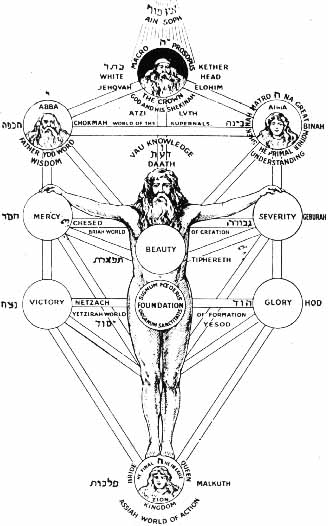
The Cabalistic interpretation does not end here. The space within the circle is clearly divided into four parts which correspond to the four worlds of the Cabala and correct Roses/Sephiroth of the Cross/Tree of Life appear in each world, as well as figures of gradually more and more spiritually evolved people. Above God the Father/Kether and outside the circle of roses is a veronica held by two angels which obviously corresponds to the veils of En-Soph (and is difficult to explain otherwise). And thus the woodcut by Kulmbach can be seen as containing a complete Cabalistic world view.

A question arises whether this woodcut contains genuine proto-Rosicrucian symbols or whether it is just a coincidence. To answer this question positively we must find a similar image in early Rosicrucian literature. Fortunately, it is not a difficult task, since a work often referred to as "the fourth manifesto", Speculum Sophicum Rhodo-Stauroticum, contains on its title page a detail which is identical in concept with the woodcut of Kulmbach, though simplified to a great extent. It is a small cross surrounded by a wreath containing four roses and it appears to be the only image of the Rosy Cross in the earliest, and generally believed to be authentic, Rosicrucian writings. It is also the only rose and the only cross on that title page and therefore it must be the Rosy Cross of the Rosicrucians.
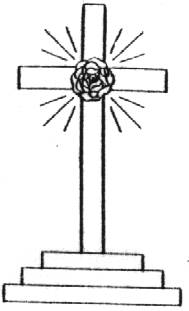
The other example of a rosy cross symbol I want to give is that shown on the central panel of Herbaville Triptych, which is Byzantine and comes from the 10th or 11th century. The symbol is a Calvary cross with a rose in its centre, which is identical with what Manly Palmer Hall considers to be the original symbol of the Rosicrucians. Additionally there are also roses at the end of each arm of the cross. The roses are eight-petalled and with three circles of petals, suggestive of the 19th century Golden Dawn symbol, but this is most probably a coincidence.
The above does not prove, of course, that there existed any
organisation or secret society using the Rosy Cross and
possessing a body of esoteric teachings, as some modern
"Rosicrucian" organizations maintains. However, the woodcut by
Kulmbach seems to indicate that the rose joined to the cross was
somehow connected with Hermetic thought as early as the beginning
of the 16th century. The Byzantine Rosy Cross may confirm my
previous hypothesis of the Templar origin of the symbol, as the
Order of the Temple had connections with the Byzantine Empire.
However, there is one more instance of that symbol, which
suggests a still earlier origin. It occurs as a sceptre held by
St. Luke on the miniature in St. Chad Gospels of the 8th century. 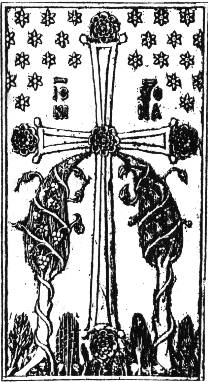
He holds it along with the bishop's staff and it is described as the royal sceptre of power. But it seems strange that St. Luke should hold a royal symbol, so perhaps the two staffs are symbolic of the two sides of the teachings: the exoteric (bishop's staff) and the esoteric (the rosy cross sceptre)?
Sources of Illustrations
1 A Rosy Wreath by Hans Suess von Kulmbach, woodcut, 1515
(Barbara Miodanska, Miniatury Stanislawa Samostrzelnika, Warsaw
1983).
|
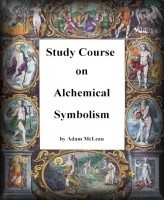 Study Courses
Study Courses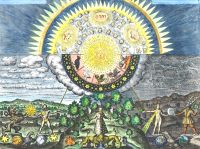 Alchemical, astrological and emblematic art prints  Alchemy and art  Art books Series 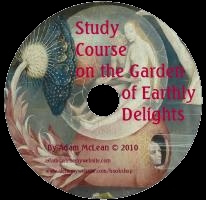 Study course on Bosch's Garden of Earthly Delights New Hieronymus Bosch Website |